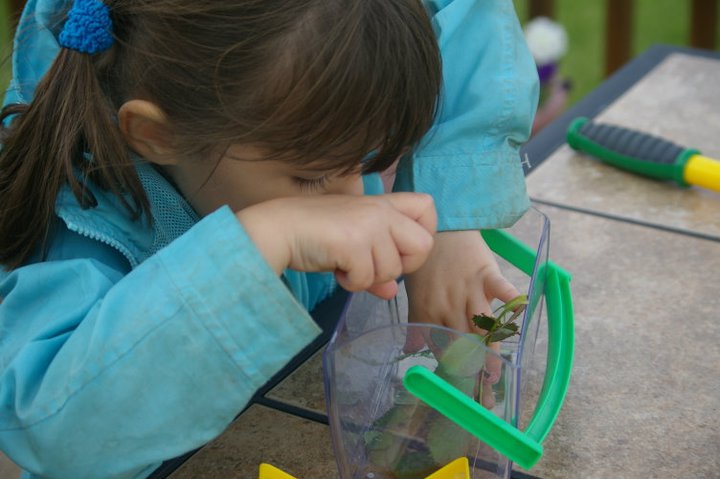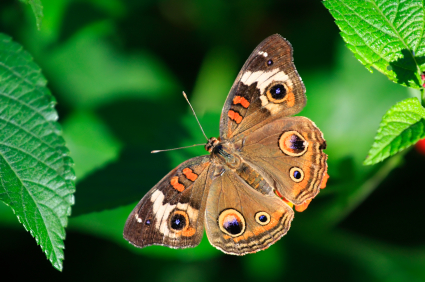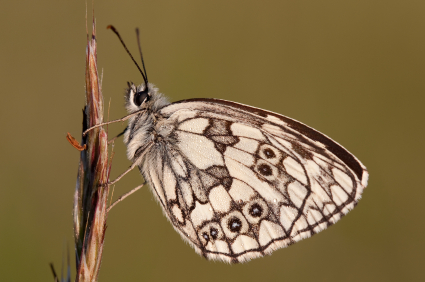
My daughter is fascinated by butterflies. We have at least three books on her bookshelf about butterfly life cycles, and just the other week, a trip to the library yielded yet another butterfly book for bedtime reading. Butterflies are fascinating creatures. Not just for the four-year-old who wonders in awe at their amazing life cycle, but for the biologist who marvels at the development of the intricate pattern of their wing eyespots. Wing patterns in butterflies are amazingly varied among species and between different wing surfaces (forewing and hindwing) of the same individual. How are these patterns determined?
Apparently, I’m not the only biologist wondering how a butterfly gets its spots. Saenko et al. recently published an article in EvoDevo in which they describe the involvement of the Hox gene Antennapedia (Antp) in the development of wing eyespots in the butterfly Bicyclus anynana. In this study the authors explored the genes and signaling networks involved in the post-embryonic patterning required for establishing eyespots.
 The Hox genes encode proteins that are essential for specifying segments (patterning) during embryonic development. They are expressed in evolutionarily conserved patterns along the anterior-to-posterior axis of embryos. Although a great deal is known about these genes and the roles they play in embryonic patterning, relatively little is known about their role in determining post-embryonic lineage-specific traits.
The Hox genes encode proteins that are essential for specifying segments (patterning) during embryonic development. They are expressed in evolutionarily conserved patterns along the anterior-to-posterior axis of embryos. Although a great deal is known about these genes and the roles they play in embryonic patterning, relatively little is known about their role in determining post-embryonic lineage-specific traits.
Many butterflies of the family Nymphalidae have a series of marginal eyespots that consist of concentric rings of contrasting colors. A morphogen model for wing eyespot formation, suggesting that color rings are induced in a concentration-dependent manner by morphogens produced from the wing eyespot organizer (center), has been proposed. These organizers are established during the last instar larval stage, and have been shown to involve Hedgehog and Notch signaling pathways and Distal-less and Spalt transcription factors.
In this study, the authors looked at expression of two Hox genes Ultrabithorax (Ubx) and Antennapedia (Antp) at both the protein and mRNA level in butterfly larval wing discs when eyespot organizers are established. The were able to show that Antp expression is upregulated shortly after the last molt, earlier than any other genes known to be involved in eyespot organizer areas. The Antp protein was detected in discrete spots along the forewing and hindwing that corresponded to eyespot organizers. However, Ubx was expressed in its evolutionarily conserved pattern, hindwing only, no expression or staining in forewing, consistent with its role in specifying the third thoracic segment. These results suggest that Antp has been “recruited” for a new function after embryogenesis, establishment of wing eyespots.
 The authors decided to look at additional species to see if this expression of Antp at the earliest stages of eyespot organizer establishment was conserved. They looked at eyespot formation in Junonia coenia, a species believed to have diverged from B. anynana 90 MYA but has similar-looking eyespots. They did not detect Antp expression in eyespot organizers in J. coenia. By contrast, Notch and Distal-less were detected in eyespot organizers in both species.
The authors decided to look at additional species to see if this expression of Antp at the earliest stages of eyespot organizer establishment was conserved. They looked at eyespot formation in Junonia coenia, a species believed to have diverged from B. anynana 90 MYA but has similar-looking eyespots. They did not detect Antp expression in eyespot organizers in J. coenia. By contrast, Notch and Distal-less were detected in eyespot organizers in both species.
The signaling protein Hedgehog had previously been shown to be involved in establishment of eyespot organizers in J. coenia, but the authors of this study did not detect Hedgehog or its receptor Ptc in B. anayana eyespot organizers. These results suggest genetic divergence in eyespot organizer establishment. Indeed looking at more species further supports these results. Four examined species of the tribe Satyrini, to which B. anynana belongs, all showed Antp, Notch and Distal-less expression associated with eyespot organizers; another member of the same subfamily revealed only Antp expression. However when butterflies of subfamily Nyphalinae, to which J. coenia belongs, were studied, no Antp expression was detected. So, while some pieces of the eyespot specification pathway may be conserved among species others are divergent.
 So, how does a butterfly get its spots? Apparently it recruits old genes to new purposes, but not all butterflies recruit the same old genes.
So, how does a butterfly get its spots? Apparently it recruits old genes to new purposes, but not all butterflies recruit the same old genes.
Reference
Saenko SV, Marialva MS and Beldade P (2011). Involvement of the conserved Hox gene Antennapedia in the development and evolution of a novel trait. EvoDevo, 2 PMID: 21504568
Michele Arduengo
Latest posts by Michele Arduengo (see all)
- An Unexpected Role for RNA Methylation in Mitosis Leads to New Understanding of Neurodevelopmental Disorders - March 27, 2025
- Unlocking the Secrets of ADP-Ribosylation with Arg-C Ultra Protease, a Key Enzyme for Studying Ester-Linked Protein Modifications - November 13, 2024
- Exploring the Respiratory Virus Landscape: Pre-Pandemic Data and Pandemic Preparedness - October 29, 2024
